Other common names:
- Broadleaf dock: bitter dock, blunt-leaved dock, red-veined dock, broad-leaved dock, celery seed
- Curly dock: yellow dock, sour dock, narrow-leaved dock, curled dock
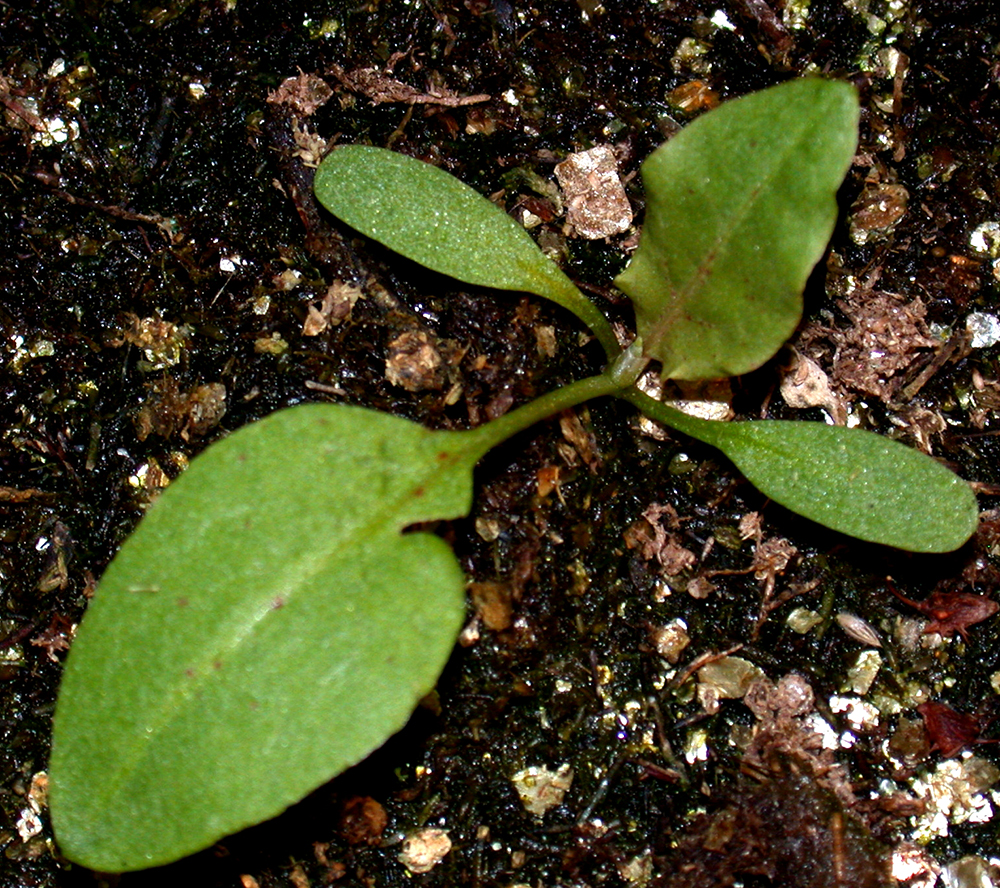
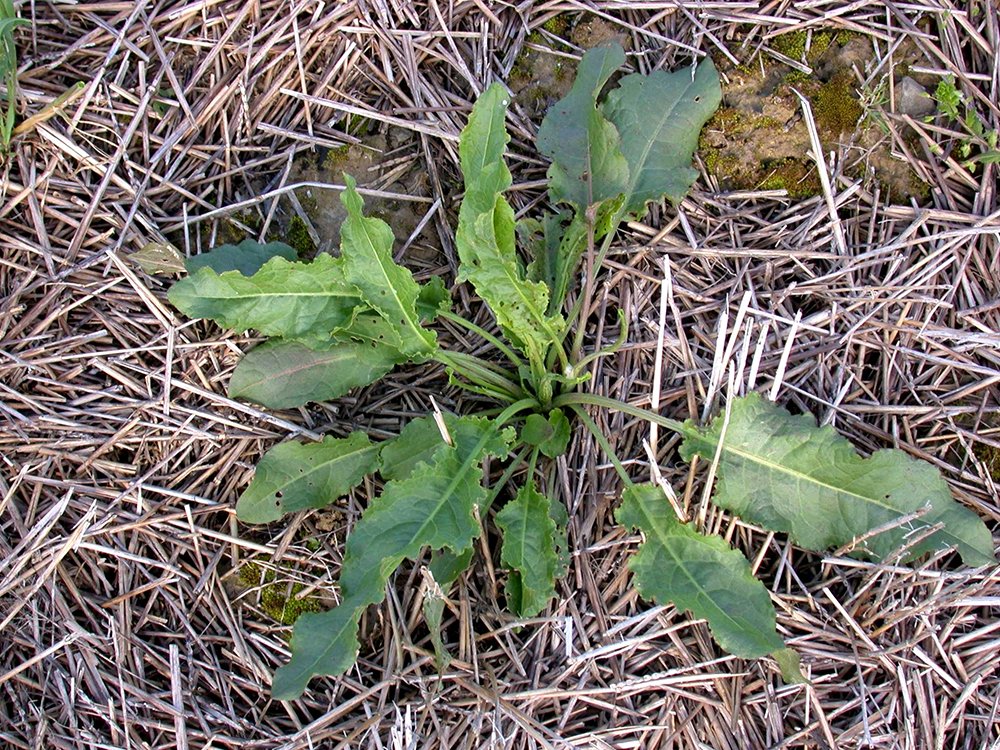
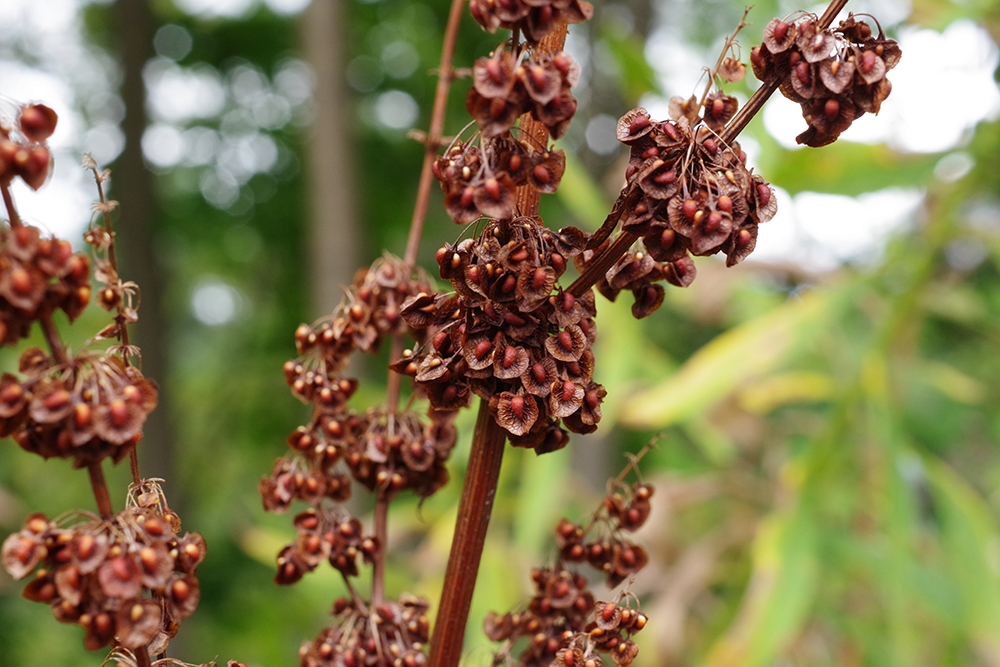
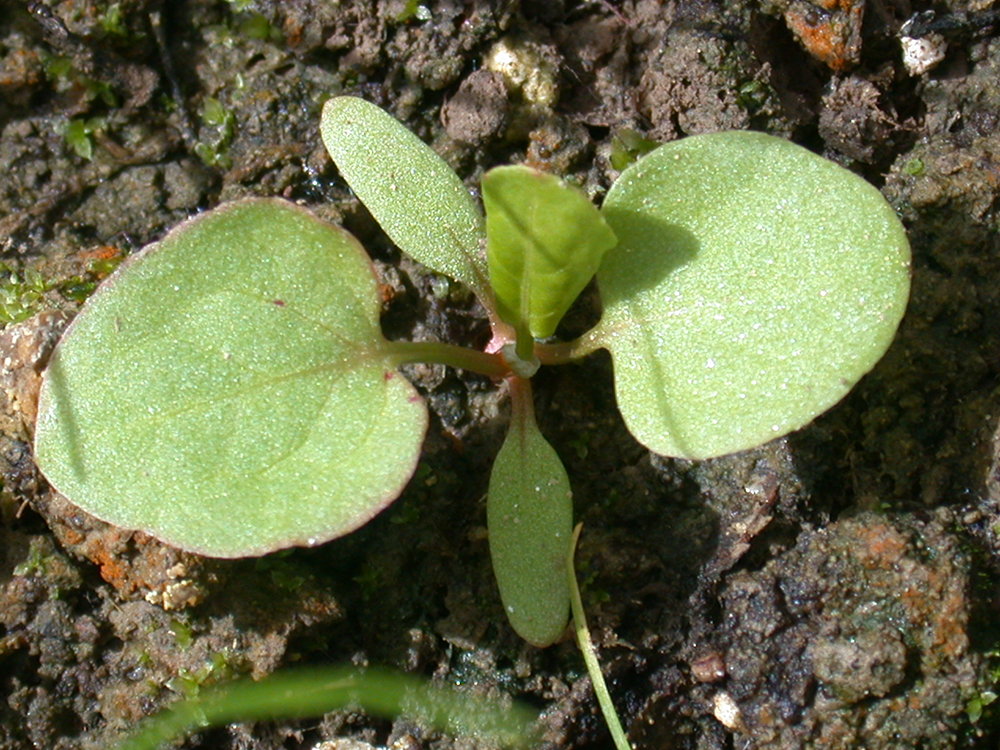
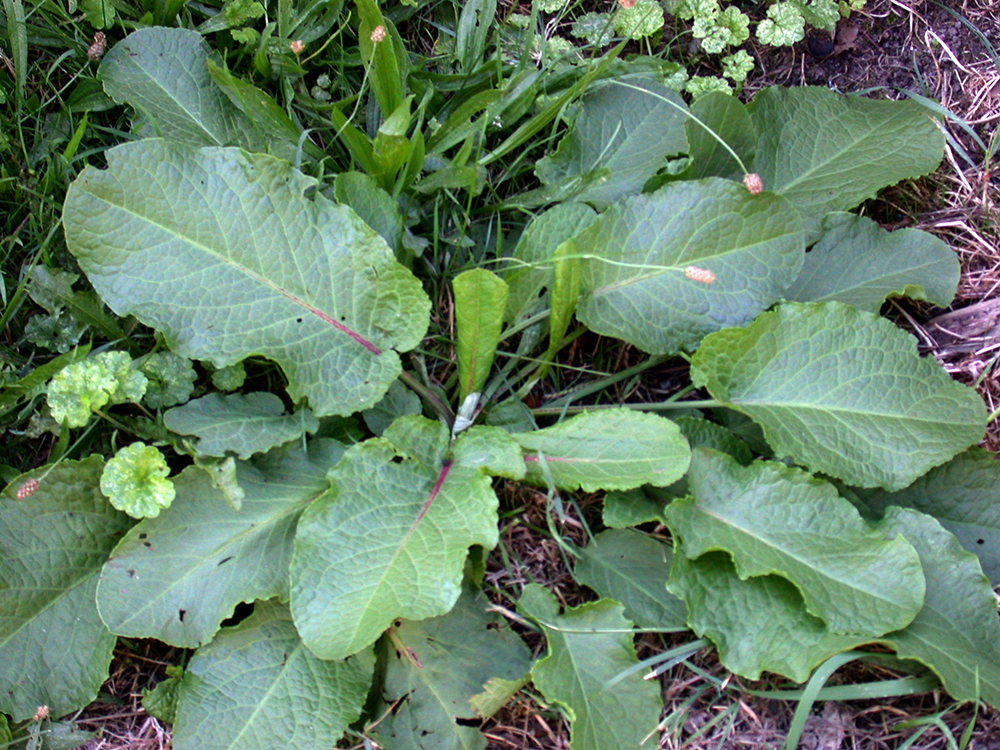
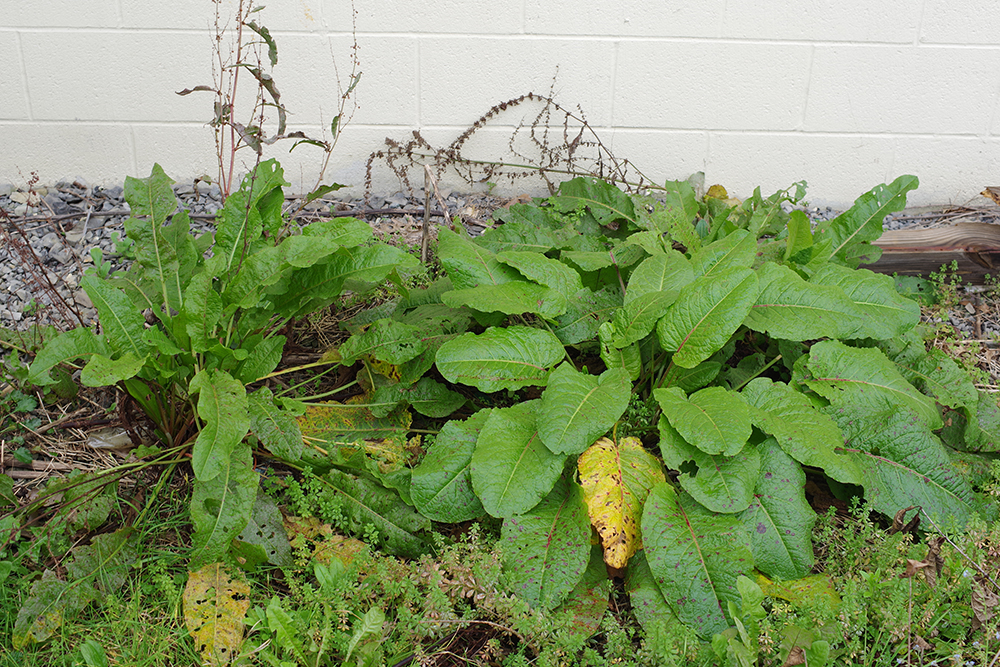
Broadleaf dock, Rumex obtusifolius L.
Curly dock, Rumex crispus L.
Identification of Docks
Family: Buckwheat family, Polygonaceae
Habit: Erect, taprooted, perennial herbs with basal rosettes of large leaves
Description: Young leaves of seedlings develop basal rosettes. Leaf edges unfurl outwards from underneath the leaf.
- Broadleaf dock: Cotyledons are egg shaped, 0.4–0.7 inch long by 0.14–0.25 inch wide and gritty on both sides. First true leaves are ovate to oblong shaped. All subsequent young leaves are oblong and wavy edged; they have heart-shaped bases, white hairs beneath their stalks and midveins, and possible red flecking on the veins and blade.
- Curly dock: Thumb shaped cotyledons are hairless, gritty to the touch, and 0.3–0.6 inch long by 0.1–0.2 inch wide with fleshy, possibly red-flecked, dull green upper sides and pale green undersides. Cotyledon leaf stalks are ridged. Stems are green with a red base. The young true leaves are egg shaped, smooth and flat along edges, hairless and possibly red-flecked.
Mature plants form vigorous basal rosettes. All leaves have a transparent, thin membrane (ocrea) covering the leaf-stem juncture. Flower stalks are chestnut to red-brown with smaller and more tapered leaves than those in the rosette. The underground part of both species consists of a large, fleshy, yellow taproot that is surmounted by about 2 inches of underground stem containing many buds. The root and underground stem are difficult to distinguish but behave differently when fragmented by tillage (see the section “Response to disturbance”).
- Broadleaf dock: Leaves are 12 inches long by 6 inches wide, hairless, tapered and heart shaped at the base; they are flatter, less wavy, broader and less crinkled than curly dock. Lower leaf stalks may have red veins. The taproot is usually highly branched.
- Curly dock: Rosette leaves are curly, wavy, crinkly edged, elongated and tapered at the base. Rosette leaves are 6–12 inches long and up to 2.5 inches wide. Stem leaves are up to 6 inches long and 1 inch wide. Leaves are alternate, hairless, shiny, green and increasingly ruddy as the season progresses. The taproot is often unbranched or only minimally branched.
Flowers are green-red, inconspicuous, small, without petals and arranged into spiral clusters at the ends of closely spaced stalk branches. Individual flowers hang from the cluster on small stalks. The inflorescence turns red-brown as the seeds mature.
- Broadleaf dock: Stalks are hairless, 3–4 feet tall and occasionally present in small groups. Flowers are 0.07–0.1 inch wide. Clusters make up two thirds of the stem length.
- Curly dock: Stalks are jointed, reddish-brown, hairless and up to 5 feet tall. Flowers are 0.25 inch wide. Clusters are 6–24 inches long.
Fruit and seeds: Both species have heart-like, winged, brown fruits surrounding three-sided, teardrop-shaped, glossy, reddish brown seeds.
- Broadleaf dock: Wings on fruits are reddish brown, 0.13–0.25 inch long, toothed and spiny. Seeds are 0.08 inch long when removed from fruit.
- Curly dock: Wings on fruits are corky or papery, dark brown, 0.13–0.25 inch long and entire. Seeds are 0.07 inch long when removed from fruit.
Similar species: Common burdock (Arctium minus Bernh.) and great burdock (Arctium lappa L.) have young seedlings similar to the docks. Seedlings of burdocks have smooth, shiny cotyledons with downy undersides. Young true leaves have leaf stalks that encase the stem, whereas dock stems extend around the leaf stalk. Docks have ocreae, whereas burdocks do not.
Management of Docks
Both species proliferate in poorly managed pastures. They establish well in bare, trampled areas where livestock congregate. With intensive rotational grazing, small dock plants are eaten and trampled back before they get well established, and the rapid regrowth of the grass will tend to out-compete the dock. Broadleaf dock had fewer plants and smaller taproots when ryegrass-white clover swards were cut four times per season (simulating grazing) than when cut twice per season (for silage). Other experiments have shown similar decreases in vigor of dock as cutting frequency increases. Although most livestock will not eat dock unless it is very young, deer and some breeds of sheep will eat even large plants. High seeding rates reduce dock infestations in newly established crops of both grasses and alfalfa. Similarly, undersowing to increase the density of thinning grass stands can help suppress dock.
In both forage crops and annual crops dock problems increase with over fertilization. Moderate fertility rates are the key: You want enough nitrogen for the crop to grow vigorously and to compete with the dock for light, but excess N will favor the dock relative to the crop.
Tillage is effective for managing dock. The worst problems in annual crops come when the field is rotated from a perennial forage to an annual crop. If the dock becomes old and dense in the forage phase of the rotation, special measures are needed to get it under control. One way to do this is to plow the field in mid-summer and work the dock roots to the surface where they can dry out using a spring tooth harrow. Turn the soil and roots periodically with the harrow to ensure a good kill. Another successful approach is to rototill the field to a depth of about 4 inches. This will chew up the underground vertical stem from which most new shoots arise. The rotary tillage should be slow to pulverize the underground stems to the maximum degree. Simply severing the neck from the root can actually increase regeneration. Follow the initial rotary tillage with faster passes using other implements to kill new sprouts. This approach can be used to spot-treat heavily infested areas of a pasture or forage field. Successive tillage operations should occur when the leaves are 2 inches long. Moldboard plowing will reduce dock populations, but some plants will recover even from burial at the bottom of the plow layer. A mechanical dock puller that can remove 600 plants per hour has been developed in Germany.
Since both dock species have very long growing seasons, winter cover crops help to suppress dock populations through competition. Prevention of new infestations (see the section “Dispersal”) and early eradication of isolated plants can prevent much grief, particularly on farms with perennial forage and pasture.
Ecology of Docks
Origin and distribution: Both species are native to Europe. Both species have been introduced widely in Asia, Africa, Australia and North and South America. Broadleaf dock occurs as far north as Greenland, and curly dock occurs in Iceland and the interior of Alaska. In North America, broadleaf dock is most common east of the Mississippi River and in the Pacific Northwest, with populations more scattered in the Great Plains and Inter-Mountain states. Curly dock, however, occurs throughout the United States and the agricultural zones of Canada.
Seed weight: Mean population seed weights of broadleaf dock range from 0.7–2.8 mg. Mean population seed weights of curly dock range from 1–3 mg with most near 1.4 mg.
Dormancy and germination: For both species, seed dormancy characteristics apparently depend on growth conditions and vary greatly between individuals and position of the seed on the seed stalk. Broadleaf dock seeds are dormant when shed but gradually lose dormancy during succeeding months. Germination occurs at 50–95°F with maximum germination at 68–77°F. Temperature alternation and light increased germination, whereas exposure to light filtered through leaves decreased germination. Exposure to high nitrate levels reduces germination at optimal light levels. Seeds from early bolting plants are more dormant than those from late bolting plants.
Curly dock seeds are dormant when the dry fruit hull surrounding the seed restricts germination, but they also may be non-dormant when shed at maturity in summer. Exposure of moist seeds to low temperatures (32–59°F) for one or more weeks breaks dormancy. Exposure to temperature alternations and light promote germination. Seeds germinate in response to a wide range of alternating day/night temperatures, ranging from 68/50°F to 95/68°F. High N along with a deficiency of P and K fertilization of the mother plant reduces seed germination. Secondary dormancy can be induced by several days of warm temperatures (up to 86°F) or dry conditions. Although most research has been conducted on each of these species separately, an extensive review suggests both species have similar dormancy and germination behavior.
Seed longevity: Seeds of broadleaf dock have been shown to survive at least 40 years under favorable conditions, and seeds of curly dock can remain viable in the soil for as long as 80 years. In pastures, seed densities of several thousand per square foot are common. Nevertheless, seed mortality can be high; in one experiment in Ontario, less than 15% of curly dock seeds and 1% of broadleaf dock seeds survived more than one year. In a series of five-year experiments in which the top 3 inches of soil was stirred three times per year, seeds of curly dock declined by an average of 37–47% per year, and seeds of broadleaf dock declined by 49–56% per year.
Season of emergence: Seedlings emerge throughout the growing season, but notable flushes of emergence occur during the spring and fall when soil temperature is above 59°F and daily fluctuations are greatest. Overwintering rosettes resume growth in early spring.
Emergence depth: Emergence of dock seedlings is best at or near the soil surface, but a few seedlings can emerge from as deep as 2–3 inches. Emergence from fragments of belowground stem can occur from a depth of 6 inches if soil is not waterlogged, but emergence is best from 0–3 inches.
Photosynthetic pathway: C3
Sensitivity to frost: Established plants of both species are very frost tolerant and commonly overwinter with a rosette of small reddish leaves, though curly dock sometimes dies completely back to the ground. Seedlings of broadleaf dock are frost sensitive.
Drought tolerance: Mature plants of broadleaf dock are drought tolerant, but seedlings can die from prolonged drought conditions. Curly dock is very drought tolerant.
Mycorrhiza: Most reports describe the absence of mycorrhiza from both species. However, one study reported the presence of mycorrhiza.
Response to fertility: Both species respond strongly to N, and their high abundance is an indicator of excessive N fertility. Curly dock responds most to N and P together, and seed production is enhanced most by balanced N, P and K. Curly dock responds more to P than to K. Curly dock foliage contains high concentrations of Zn, but whether it also requires high Zn levels in the soil is unclear.
Soil physical requirements: These species are present on almost all soil types but less so on peat or very acidic soils. Curly dock is an indicator of compaction. It tolerates waterlogged soils and several weeks of complete immersion in flood water.
Response to shade: Neither species establishes well in closed communities, such as a well-managed, vigorous pasture. However, regrowth after a period of intense competition and shading was surprisingly high.
Sensitivity to disturbance: Mowing has little effect on aboveground growth of both species but reduces belowground growth. Leaves are quickly regenerated, and mowing induces production of new flowering stalks. Broadleaf dock was better adapted to frequently cut grasslands than curly dock because of greater investment in root biomass. Docks tolerate extreme trampling and often become dominant in areas where cattle congregate. New plants establish readily from fragments of the short, vertical underground stem that sits on top of the roots. New plants will also form from fragments of the true root, but apparently only in the spring.
Time from emergence to reproduction: Broadleaf dock rarely flowers during the first season. Curly dock can flower during either the first or second season, depending on conditions. In subsequent years, both species make new flower stalks repeatedly from spring until hard frost in late autumn. Curly dock that begins regrowth in early February to March will begin flowering in April to early May. Seeds mature six to 18 days after flowers open. The majority of plants become capable of regeneration from rootstock at 38–51 days after planting.
Pollination: Both species are wind and bee pollinated, but both have a high degree of self-fertility.
Reproduction: Seed production is proportional to the size of the plant and varies from 100 to over 60,000 seeds. About half of curly dock plants die after flowering, and a typical plant lives about three years. Both species are relatively short-lived perennials with less than 2% of broadleaf dock and 4–24% of curly dock surviving for more than four years. Vegetative reproduction is limited to expansion of the diameter of old clumps unless the plant is broken by tillage. Flowering plants allocate substantially less biomass to roots than non-flowering plants. Even after tillage, most new individuals arise from seeds rather than from fragments of roots or underground stalks.
Dispersal: The seeds blow short distances in the wind. They also disperse by floating on water. The wings of the fruit tend to cling to clothing and the fur of animals. Much long distance dispersal probably occurs, however, by passage through livestock, with the seeds being deposited in new locations when the animals are moved or the manure is spread. The seeds in manure often come from infested pastures. Seeds may also be present in small grain, forage and cover crop seed. Birds also disperse the seeds.
Common natural enemies: Deer apparently prefer dock over other forage. Host specific natural enemies normally cause little damage to these species. In an experiment, simultaneous application of the rust Uromyces rumicis and the beetle Gastrophysa viridula greatly reduced leaf area and subsequent regrowth of broadleaf dock. Curly dock was more susceptible than broadleaf dock to U. rumicis infection.
Palatability: Leaves of broadleaf dock were formerly cooked and eaten like spinach, and also fed to pigs. Cattle, sheep, horses, rabbits and chickens all reject the foliage and may be poisoned if forced to eat it due to lack of other forage. Curly dock has low digestibility and palatability and was completely rejected by grazing lambs.
Note: Extracts and residue of broadleaf dock inhibit growth of a wide range of crops, including white clover, sunflowers, wheat, corn and soybeans.
Summary Table of Docks Characteristics
| Dock species | ||||||||
|---|---|---|---|---|---|---|---|---|
| Growth habit | Perennial overwinter organ | Emergence period from perennial organs | Optimum emergence depth (inches) from perennial organs | Time/stage of lowest reserves | Photosynthesis Type | Frost tolerance | Drought tolerance | Mycorrhiza |
| rosette | taproot | early spring | 0–3 | – | C3 | high | high | no |
| Fertility response | Importance of seeds to weediness | Seed weight (mg) | Dormancy of shed seeds | Factors breaking dormancy | Optimum temperarature range (F) for seed germination | Seedling emergence period | Emergence to flowering (weeks) | |
| high | high | 0.7–3 | variable | cms, li, at | 68/50 to 95/68 | spring and fall | 4–8 | |
Table Key
Perennial overwinter organ: Principal plant organ that survives winter and from which growth resumes in subsequent years.
Emergence period from perennial organs: Time of year when most emergence occurs from perennial overwintering organs in the typical regions of occurrence for each weed. Some emergence may occur outside of this range.
Optimum emergence depth from perennial organs: Soil depths (in inches below the soil surface) from which most shoots emerge from perennial organs. Lower rates of emergence usually will occur at depths above or below this range.
Time/stage of lowest reserves: Time of year and/or weed growth stage at which carbohydrate reserves are lowest. This usually corresponds to the time when the weed is most susceptible to weed management operations.
Frost tolerance: Relative tolerance of aboveground shoots to freezing temperatures (high, moderate, low).
Drought tolerance: Relative tolerance of aboveground plants to drought (high, moderate, low).
Importance of seeds to weediness: The relative importance of seeds to dispersal, genetic diversity and survival of the species as a weed in agricultural environments (high, moderate, low). Emergence to flowering: Length of time (weeks) after emergence from perennial organs to the beginning of flowering in the typical regions of occurrence. Note that this refers to established perennial plants, recognizing that some species may not flower in their initial year of establishment.
Further Reading
Cavers, P.B. and J.L. Harper. 1964. Rumex obtusifolius L. and R. crispus L. Journal of Ecology 51: 737–766.
Niggli, U., J. Nösberger and J. Lehmann. 1993. Effects of nitrogen fertilization and cutting frequency on the competitive ability and the regrowth capacity of Rumex obtusifolius L. in several grass swards. Weed Research 33: 131–137.
Pye, A., L. Anderson and H. Fogelfors. 2011. Intense fragmentation and deep burial reduce emergence of Rumex crispus L. Acta Agriculturae Scandinavica, Section B—Soil and Plant Science 61(5): 431–437.
Zaller, J.G. 2004. Ecology and non-chemical control of Rumex crispus and R. obtusifolius (Polygonaceae): a review. Weed Research 44: 414–432.

